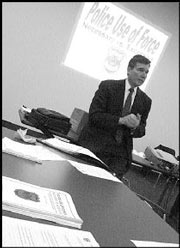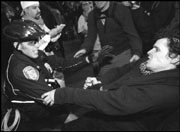I walk into a garage, where two men seem to have just finished raping a woman who’s still lying on the floor. I’m telling them, then shouting at them, to step out of the garage, but they aren’t responding. Before I can figure out something more appropriate to say or do, one of the men rushes me with a knife, and I raise my gun and put three rounds into him that don’t even slow him down. Just as he reaches me, the video simulation ends, the lights come on, and I turn to face seven people who were watching me badly stumble my way through an elementary training simulation at the Seattle Police Department’s firing range in Tukwila.
The simulation was part of “Police Use of Force: Necessary vs. Excessive,” a public-outreach program this month sponsored by the Seattle Police Department. Role-playing, lectures, discussions—the simulation was one of a number of walk-in-our-shoes initiatives meant to help ease the distrust many people, especially African Americans, feel toward the police. Though such outreach is not new, officials increasingly are turning to programs like this one to deal with tension over allegations of police misconduct.
WHEN MAYOR GREG NICKELS ignored the City Council’s nonbinding resolution to address racial profiling this summer and created his own, an important part of Nickels’ plan focused on outreach—polling about police issues, community forums, and opportunities to ride along with officers.
Similarly, King County Sheriff Dave Reichert recently suggested to the Seattle Post-Intelligencer that people upset over the police shooting of Robert Thomas Sr. should attend a Nov. 13-14 conference in Bellevue—”Cultures and Law Enforcement” —sponsored by the Washington State Sheriff’s Association. Thomas Sr., who was black, was shot and killed on April 7 by King County Deputy Melvin Miller, who is white, during a brief altercation that escalated. Thomas Sr. was also armed. An inquest found no problem with Miller’s conduct, King County Prosecutor Norm Maleng declined to file charges against Miller, and several other investigations are ongoing. The controversy surrounding the incident has made already-bad police relations with local communities of color much worse, inspiring numerous protests.
The Washington State Patrol had an event on Tuesday at Seattle Central Community College especially meant to reach out to Seattle’s racial and ethnic minorities. The Seattle Police Department (SPD) has four community meetings planned for November. Even the local FBI recently made its video simulation program available to members of the media to help them better understand police issues.
As part of all this police outreach, Cathy Wenderoth, strategic advisor for SPD’s Community Services and Support Bureau, sought some of the police department’s biggest critics when she organized the “Use of Force” seminar. “We wanted to get the people who were the first to jump up and down when there’s a use of force incident,” she told participants.
But for reasons she should have seen coming, that never happened. The seminar was held on two consecutive Friday afternoons, making it difficult for busy activists to attend. Holding the seminar at the police firing range and in the basement of the new West Precinct headquarters downtown, and then having all the presentations and moderation done by police officers, also might not have been the best way to attract police critics.
Of the roughly 15 people who confirmed they would attend the two half-day events, only five—including me—showed up the first day. Only two showed on the second day. Many more, including a number of prominent civil-rights activists, public defenders, and African-American clergymen, refused to participate.
Conversations with some of those invited revealed a deep suspicion about police motivations for putting on the event. “I resist participating in events like this,” said one activist who refused to attend, “because it seems the logic behind them is, ‘If you just knew what it’s like being a cop, you’d stop thinking that police misconduct is a problem.'”
Police, meanwhile, were frustrated by the low turnout, which some blamed on civil-rights activists. “People don’t want to know the facts,” one officer lamented to me the first day of the seminar.
WHAT FACTS DID he mean? What do you get from participating in these events?
The answers differ for everyone. But already, after the first of the two programs—five hours of presentations and role plays in which you try to imagine yourself as a police officer in a host of ambiguous and potentially life-threatening situations—I was feeling personally overwhelmed and a little nauseous.
Hypothetical situation after hypothetical situation was tossed our way, and I found myself feeling resentful for having to state my opinion, to make a quick decision, and especially to do so in front of other people who could judge me severely as I decided whether or not someone should be shot or if and how they should be “subdued.”
Welcome to the life of a police officer.
“How easy is it to make a decision in the safety or sanctity of our own home?” asks Jeff Geoohagan, a SWAT-team instructor for SPD. Meanwhile, “Police have to make split-second decisions.” To emphasize the point, Geoohagan shows us videotape from the car of a police officer who was shot to death by a motorist during a routine traffic stop. We watch the officer collapse and die in the brief it-could-happen-to-anyone shoot-out, and then we break for a snack before doing video simulations.
Small talk anyone?
The experience is powerful. What would sound like clich鳠about policing—that cops worry every day about being able to come home alive to their families, that most cops who die on the job are killed with their own weapons when they’re too relaxed, that cops have to make split-second, life-or-death decisions—only become real when you have to make those decisions yourself. When you can’t come to an easy answer, or when your answers conflict, or when, just pretending to be a cop, you say things that you know would sound bad in the papers or could even get you sued, you begin to realize how easy it is for cops to rally around each other as they carry out what has to be one of the toughest jobs in the world.
In trying to share the stress and complexity police officers face, the seminar was less about hearing both sides of the story and more about creating a setting in which cops could seek recognition they feel is so lacking in the media.
“Morale is low,” officer Kevin Jones told me as I accompanied him on his night patrol recently. “It seems like the only time the public says good things about us is when there’s a tragedy. But then it’s too late—somebody’s dead.” He later added: “If people actually saw what we do, they’d understand.”
AND SO THE FEW people who attended “Use of Force” heard a lot about police perspectives: that even though police are always exonerated by inquests, many feel tarred and feathered as racists, under siege by media sensationalism, and victimized for simply doing their job. Only after a day of presentations did we have a valuable two-way discussion with raw feelings about race, inquests, and just about every other police issue getting media attention these days. But like a room full of white progressives asking why there are no people of color in their supposedly populist organizations, event organizers were left naively asking at the end of the day: Why are we talking to ourselves? Where are all the people of color?
“I don’t want the work that was put into this thrown out the door,” Wenderoth says as she discusses how to bring more people to the table next time. The volunteer citizen group Wenderoth works with—Community Policing Action Council (CPAC)—has a host of outreach projects it coordinates with Seattle police, including police-citizen dialogue through precinct councils, 11 advisory committees, occasional forums, and a 13-week course that introduces citizens to a broad overview of police practices. In January, CPAC hopes to sponsor “conversation cafes” so citizens can meet with their local police officers over coffee.
But the poor turnout at “Use of Force” shows just how far CPAC has to go—not just to reduce community distrust of police, but to get police to overcome their distrust of civilians. “The public definitely should be involved,” officer Jones told me, referring to civilian review boards that handle complaints about police misconduct, “but they should not have the final word. They don’t know what’s going on. Citizens think we should shoot guns out of people’s hands . . . [but] this isn’t the movies.” Such distrust contributes to an adversarial and unequal relationship between police and the communities they serve.
To their credit, “Use of Force” organizers expressed a real interest in changing CPAC’s future events to be more inclusive. Organizers for the Washington State Patrol’s recent event did proactive outreach to activists like Dustin Washington from the People’s Coalition for Justice.
Washington, who consciously avoided the “Use of Force” seminar as too one-sided, is still sounding a hopeful tone that real conversations about the serious rifts between communities of color and the police will happen at some of the events this month. “Cops are in an automatic defensive mode,” he says. “A lot of the time, the way they answer questions ends up pissing people off more than it does any good. The biggest thing for them to do is just listen.”









